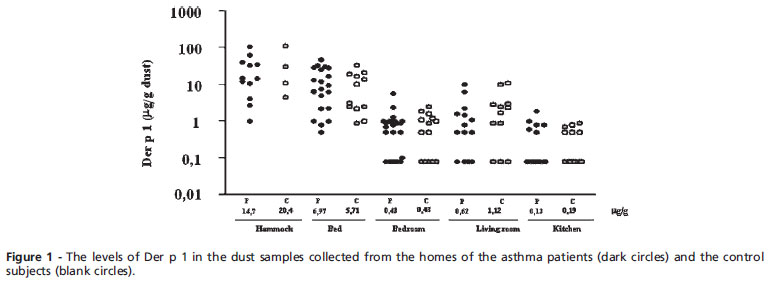INTRODUCTION: Asthma affects approximately 10% of the world's population. Sensitization to allergens is an important risk factor, and exposure to allergens is associated with disease severity. METHODS: We performed skin tests to evaluate allergen sensitization to mites, cockroaches, cats, dogs, and molds in 73 asthmatic patients. Enzyme Linked Immunosorbent Assay was used to assay the mite and cockroach allergens found in dust from the bedding, hammocks, bedroom floors, living rooms, and kitchens of 29 patients and 14 controls. RESULTS: Fifty patients (68.5%) had positive skin test responses. There were positive responses to D. pteronyssinus (52.0%), B. tropicalis (53.4%), T. putrescentiae (15.0%), E. maynei (12.3%), L. destructor (8.2%), B. germanica (20.5%), P. americana (21.9%), Felis catus (10.9%), C. herbarium (2.7%), A. alternata (4.1%), and P. notatun (1.3%). The exposure to mite and cockroach allergens was similar in the patients and the controls. The Dermatophagoides pteronyssinus Group 1 levels were highest in the beds and hammocks. The Blattella germanica Group 1 levels were highest in the kitchens, living rooms and hammocks. DISCUSSION: The positive skin tests to mites, cockroaches and cats were consistent with previous studies. D pteronyssinus was the most prevalent home dust mite, and hammocks were a source of allergens. To improve asthma prophylaxis, it is important to determine its association with mite allergen exposure in hammocks.
Asthma; Mite allergens; Cockroach allergens; Exposure; Sensitization; Skin tests; Allergen levels; Home dust; Hammock; Environmental control

